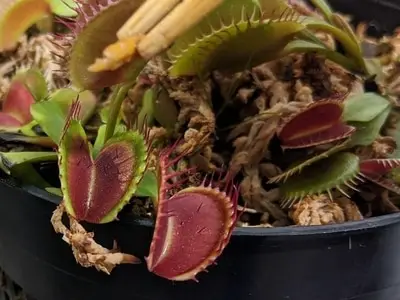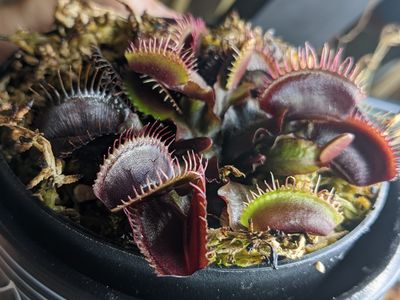When growing Venus fly traps, leaves will often turn black. In some cases leaves die due to age. In other it is due to common mistakes. In this article you will learn the most common reasons a Venus fly trap will lose leaves, plus tips for prevention.
Black leaves or yellow leaves in a Venus fly trap are simply leaves that are dying. Like with any other plant, losing a single leaf is not a problem. However, when it becomes systematic and you continue getting black leaves and not enough new leaves, then, it becomes a concern.
A single Venus fly trap plant will produce up to 7 to 9 leaves at a time. If your plant only has a couple of leaves, that can be an issue.
This is a list of common causes for black leaves.
| Causes For Leaves Turning Black in Venus Fly Traps | Category | Prevention and Fixes |
|---|---|---|
| Feeding bugs that are hard to digest or too big | Feeding | Mealworms or crickets are great food options. Opt for a bug that is 1/3 of the size of the trap to prevent black leaves. |
| Overfeeding your plant | Feeding | Only feed your plant if it is unable to capture insects. Also, only feed a maximum of 1-2 bugs a month |
| Feeding human food | Feeding | Never employ human food for your Venus fly traps. |
| Not enough lighting | Growing Conditions | Provide at least 6 hours of direct sunlight to prevent black leaves. |
| Lack of watering | Growing Conditions | Keep the soil moist at all times. Dry soil created an intense amount of stress for your plant. |
| Watering with tap water or bottled water | Growing Conditions | Only water Venus fly traps with distilled or rainwater. Tap water and bottled water contains minerals that are harmful for Venus fly traps. |
| Improper Soil | Growing Conditions | Use carnivorous plant soil for your plant. Standard potting mixes are harmful for Venus Fly trap. |
| Stress | Growing Conditions | Avoid triggering the traps if you are not feeding the plant. Also, only repot once a year. |
| Dormancy | Dormancy | The dormancy process is essential. The black leaves during dormancy are natural and essencial. |
Keep on reading for complete explanations below:
Black Leaves Due to Improper Feeding
Venus fly traps capture insects with their leaves and consume key nutrients. Depending in the prey and prey size, some leaves turn black after feeding.
The Bug Was Too Big or Hard to Digest
Venus fly traps consume insects of varied sizes, but optimally they would consume bugs that can fit completely within a trap. As a rule of thumb, insects that are 1/3 of the size of the trap are a good choice for feeding. Of course, in the wild, Venus fly traps eat any bug that becomes trapped.
When a bug is too big or difficult to consume the plant might abandon the digestion process and just let the leaf wither and turn black.
Bugs with hard shells or bigger than the trap are difficult to consume with the enzymes Venus fly traps produce. This article contains a list of the best food options for Venus fly traps.

Incorrect Food
In their natural habitat, Venus fly traps consume insects or spiders, nothing else. At home, people often experiment with human food. Feeding their plant candy, meat, fruit, cheese etc.
Venus fly traps are unable to digest human food. Feeding any type of human food to the plant will cause a black leaf and the food will rot.
Overfeeding
Venus fly traps will capture their own prey when living outdoors. Plants growing indoors will find a hard time finding bugs. It is encouraged to feed indoor plants. However, you must always consider the frequency.
Feed your plant once or twice a month. Underfeeding does not have any negative effects. However, overfeeding your Venus fly trap causes black leaves.
Poor Growing Conditions
When Venus fly traps are suffering due to challenging growing conditions, the plant will exhibit an increase in black leaves. These are the most common mistakes:
Not Enough Lighting
Venus fly traps require extended hours of strong lighting to stay healthy.
Optimally they should receive over 12 hours of direct sunlight and a minimum of 6 hours.
Venus fly traps that do not receive enough lighting will debilitate, wither and eventually die. Droopy leaves and withering leaves are a sign of improper growing conditions, often caused by lack of enough sunlight. Also, here are more reasons why your Venus fly trap is droopy.
Lack of Watering
Keeping the soil humid at all times is essential to caring for a Venus fly trap.
The media for Venus flytraps should never dry out. Arid or dry soil causes great stress to the plant which translated into black leaves.
To prevent loosing leaves, ensure the soil is always humid. it does not have to be flooded, but humid.
Watering with Tap Water or Bottled Water
Watering Venus fly traps with most tap water and bottled water will produce harm.
Most water contains minerals, which are harmless for people and most plants, but deadly for Venus fly traps.
Employing water that contains minerals will cause mineral burns in the leaves. The damage often looks like yellow spots, or yellowing of the traps. After yellowing, the leaves turn black and wither completely.
Only water Venus fly traps with the following to prevent mineral damage:
- Distilled water
- Ro water
- Rainwater
Employing the incorrect water will eventually kill the plant.
Improper Soil
Venus fly traps must be potted with carnivorous plant media exclusively.
Most potting soil is unsuitable for Venus fly traps as it contains an extensive number of minerals and additives that are harmful for Venus flytraps.
MiracleGro and other common brands of soil, kill Venus fly traps. Causing the improper media will kill the plant. First, you might notice only a few black leaves. Then, the plant will continue to decay.
Stress
There are many ways you could be creating stress for your plant that translates into an increased production of black leaves:
- Triggering the traps constantly. The leaves have the trapping mechanism to capture bugs. Activating the leaves for no reason drains the plant’s energy and generates stress
- Constant repotting: repotting once a year is enough for Venus fly traps. Additional Repotting is unnecessary.
Dormancy
In their natural environments, Venus flytraps live through winters every year. When the temperature drops Venus flytraps go dormant (similar to hibernation). During dormancy Venus fly traps will often produce a high amount of black leaves. However, this is completely safe and normal.
Venus flytraps go dormant when they experience cold weather of less than 45F (7C) for couple of weeks. They remain dormant until the temperatures rise again in the spring.
An increase in black leaves is completely normal during this period. Do not be overly worried about the changes in your plant. Some plants will experience drastic changes and others very mild ones. For some people, their plant dies completely during winter and comes back to live in the spring.
The worst thing you can do is overreact and try to change things in your setup. Instead, I recommend following the dormancy care instructions that you can find here. Continue to be patient and wait as the weeks and months go by. When the temperatures start to rise you will notice significant changes in your plant. New leaves will start to grow and your plant might even produce some flowers.

Removing Black Leaves in Venus Fly Traps
Once a Venus fly trap has black leaves what should you do? Here is some guidance:
There is no need to remove the dead leaves in a Venus fly trap. However, removing the foliage does give the plant more space to grow and promotes growth.
To remove the black leaves follow these easy steps:
Separate the black leaf from the healthy leaves and employ scissors to cut the dead leaf as close to the base as possible. If the leaf is fully dried, you could also remove the trap by simply pulling it out.
Venus Fly Trap Care 101
Here is a brief overview of Venus fly trap care:
- Light: Venus flytraps need exposure to plenty of light. Optimally they should receive 12 hours of sunlight, and the minimum is 6 hours of light. The light source might be natural light or artificial lighting.
- Watering: Venus flytraps must be watered only with rainwater, distilled water, and reverse osmosis water. Tap water and bottled water kill carnivorous plants. Also, the soil of the plant must always remain moist.
- Soil: Employ nutrient-free soil for carnivorous plants. Never employ enriched soil full of fertilizers. This article covers many soil options for Venus flytraps.
- Feeding: Venus flytraps do not need to capture insects to survive, but they benefit from them greatly.
- Suitable pots: Do not place Venus flytraps in enclosed containers. Venus flytraps prefer standard plant pots with drainage halls. Depending on the plant’s size, choose a plastic or glazed ceramic container about 2-6 inches in diameter. Also, preferably employ a tall container.
- Repotting: repot the plant once a year to avoid soil compression, fungus, and mold.
- Trimming: When leaves in a Venus flytrap dry up, they turn black. Remove them once they dry out completely.
- Fertilizers: Do not fertilize Venus flytraps. The chemicals in the fertilizers can hurt the plant.
- Temperature: Keep Venus flytraps in temperatures within this range: 32 F – 95 F (0 C – 35 C). Do not burn them in the summer, and do not let them freeze solid in the winter.
- Humidity: Venus flytraps prefer humid climates but can adapt to dry environments.
- Stress: Do not play with the traps of your plant; it causes stress for the plant.
- Dormancy: Venus flytraps must undergo a dormancy period of 2-3 months during the winter. Ensure your plant will experience this yearly resting period by placing them in a cold location.


